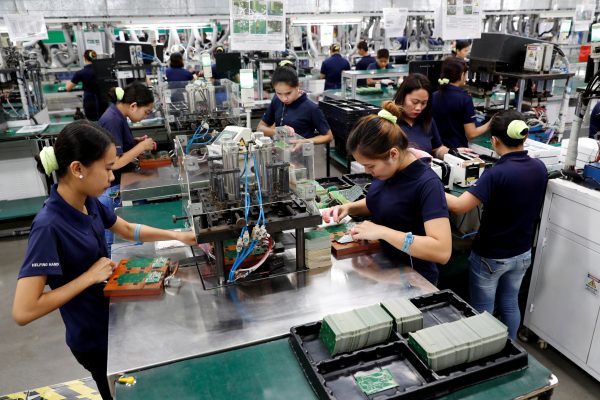Disaggregated data about economies give clues about where growth is happening and help policymakers shape appropriate policy responses. But when countries produce growth reports, data is usually only disaggregated by economic sector. A full picture of the contribution of men and women in an economy, among other things, cannot be obtained — at best, policymakers can disaggregate the incomes of men and women using household and establishment surveys. These provide little insight into what is happening in the informal sector.
Policymakers need to value unpaid housework and care work. Time-use surveys report that the economic contribution of women through unpaid care is large. It is likely that GDP would look very different if unpaid care was properly valued in national accounts.
The importance of economic growth to poverty reduction is well known. Poverty rates across ASEAN were cut from 19.6 to 5.5 per cent between 2005 and 2015. This reduction is largely due to sharp declines in extreme poverty in Cambodia, Vietnam and Indonesia, where headcounts in this category have more than halved since the 1990s.
A picture of poverty conditions by sex (available from countries through their official poverty statistics) gives some clue about disparities in economic opportunities between men and women. But the seemingly small differences in poverty between men and women do not provide a clear picture of gender disparities in economic opportunities. Monetary poverty is measured for the entire household — every member of a poor household is considered poor, and there is no measure of intra-household welfare.
Gender disparities in accessing economic opportunities can sometimes be revealed by measuring vulnerability. Studies that measure vulnerability provide insight into the risks to future welfare faced by specific groups, such as farmers, women, children and the elderly.
In the Philippines, the vulnerability of these groups is much higher than that simply reflected in their share in poverty. While about a fifth of Philippine women are poor according to data from 2015, more than half are at risk of being poor in the future. The corresponding estimates of poverty and vulnerability for men are similar to those for women, again masking the varying risks faced by women and men.
Several factors specifically influence the vulnerability of women in the Philippines, including how they participate in the economy. In all ASEAN economies, fewer women join the labour force. In the Philippines, about four in five working-age men are part of the labour force compared to only half of working-age women. Even in a relatively gender-equal country like the Philippines, women carry the burden of unpaid family work.
Although unemployment rates are nearly the same between men and women, the share of employed women across sectors varies with that of men. Women are dominant in services, with 7 out of 10 working women employed in the services sector. A fifth of working women are in agriculture and the rest are in industry. A third of working men are engaged in agriculture, more than two-fifths in services and the remaining fifth in industry.
While the average wage gap seems to favour women in the Philippine formal economy, huge gaps between genders can be seen in specific sectors and occupations. High-level positions generally have wages favouring women, who also have the lion’s share of the occupation. But men working as technicians and associate professionals, clerks, service workers, and shop and market sales workers are better compensated despite women having the bigger share in employment.
The traditional labour market has been designed for men, which leads to a relatively bigger share of employed women engaging in jobs that lack decent working conditions. These women either work with unregistered companies in the informal economy or as unpaid family workers. They have limited opportunities for social mobility and social protection.
Also contributing to the vulnerability of women in the Philippines is the extent to which new technologies, particularly automation, are putting jobs at risk. A study by the International Labour Organization suggests that over the next decade or two more than half of employment in Cambodia, Indonesia, the Philippines, Thailand and Vietnam is at high risk of automation.
The same report suggests that Philippine women, as well as workers who finish only primary school, are more likely to be employed in jobs that are at high risk of automation. Nearly 9 out of 10 workers in business process outsourcing firms in the Philippines, for which three-fifths of the workforce are women, face a high risk of having their jobs automated.
Data serve as inputs into social and economic policymaking and public interventions. For too long these data have focussed only on market activities and GDP, which can produce distorted policies that reinforce the status quo and do not promote inclusive economic participation. Policymakers have yet to adequately address the disproportionally large housework and care work burden that society places on women.
Approaches to poverty are largely curative but it is important to consider preventive approaches. In the wake of the Fourth Industrial Revolution, ASEAN governments and private sectors must work together to manage the disruptive consequences of automation by improving the technical and soft skills of the labour force. To manage this change effectively, policymakers will have to pay close attention to how different groups are affected, with a focus on how factors such as a gender, occupation and age interact.
Employers also need to focus attention on working conditions between men and women in all occupations and examine practices that may contribute to gender biases in the workplace, including issues related to compensation and sexual harassment. Policymakers should work to ensure that everyone gets a fair opportunity to participate in the economy and enjoy a better future.
Jose Ramon Albert is a Senior Research Fellow at the Philippine government think tank Philippine Institute for Development Studies (PIDS).
This article is abridged from a version that appears in the latest issue of East Asia Forum Quarterly, ‘Investing in Women‘.

